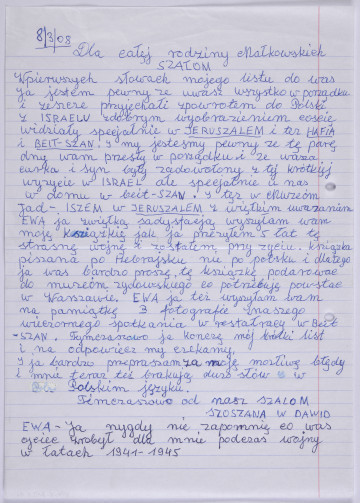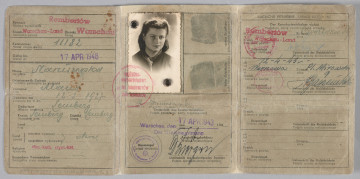
A letter
2008
Museum of the history of Polish Jews
Part of the collection: Memorabilia of Herszla from Staszów
Wooden object with metal elements, owned by Herszla from Staszów. The candlestick was probably made by Herszla himself. It was left in the Magiera family house, where Herszla stayed periodically after his escapes from the Staszów ghetto.Krzysztof Magiera, who donated the candlestick to the POLIN Museum collection as the first memento of Herszla, recalled the boy in the following way (an edited version of the interview, published under the title “Kaganek”, ed. Przemysław Kaniecki, in the magazine Midrasz, 2016, no. 6, pp. 67–69):
We slept together in one bed. We used to go to the slide. And to graze cows. […] Nobody saw us because it was a hut on the edge of the village. We didn't go into the village, so that rumours wouldn’t spread, you know.
[…] he was… not big, bigger than me, but still not big, he went barefoot, and he also didn't have a very dark complexion. His eyes were blue, as I remember. His ears were a bit protruding. This is what I remember. He had dark hair. And above all, he was cheerful. I remember he was cheerful. […] When we herded the cows one kilometre from the village, to these meadows – Krzewiny – we walked barefoot, and in short trousers. Because there was a ditch right there, water was flowing, there were frogs, so we would catch them. We drank the water, it was crystal clear. Cows were grazing in the meadow, storks were walking around. […] We used to drive the cows there at noon.
Once this thing happened. A foal was running around the yard because the mare had just given birth. And one cow was quite aggressive and once we drove the herd away and took off their halters, she was so enraged that she attacked the foal. She stabbed it with her horns and ripped its belly open! And the foal went flying, its guts blown out, and it fell down by the fence. We were crying, we held its head, not much time passed and the foal died.
But it was war. A young foal was like a young calf… The butcher came, there was food from the foal, because it was a healthy, young horse. But Herszla and I both cried over it. […] [On Sunday] [we] went out and picked apples, ran around the garden. We played with the dog. We climbed trees. Well, we did the typical boy stuff. Herszek taught me various songs, I still remember them to this day.
My goat has no shoes,
but she will have shoes,
whether red or green,
whatever she wants! Oy vey boom!
In winter we used to ice skate on the pond. Once, in the winter of 1940–1941, we got frostbite on our feet. Fire was kept at home all day to keep warm, but we got wounds, so what could we do? My grandma's brother lived with us, blind and very pious. He crushed peas in a mortar into a powder and mum would sprinkle our fingers with this pea meal.
And that uncle would urge us to pray. […] We had two beds, between them there was a cross hanging on the wall. And Herszel says: so who's this nailed to the cross?
Listen, this is our God, he’s your kin.
And then Herszel, so surprised – because of the war and the roundups – he says: so we pray to the true God, and you pray to a Jew?''
Author / creator
Dimensions
cały obiekt: height: 7 cm, width: 9 cm
Object type
lighting devices
Technique
wood, metal
Creation time / dating
Creation / finding place
Owner
POLIN Museum of the History of Polish Jews
Identification number
Location / status

2008
Museum of the history of Polish Jews

1943
Museum of the history of Polish Jews

1942 — 1943
Museum of the history of Polish Jews
DISCOVER this TOPIC
Castle Museum in Łańcut
DISCOVER this PATH
Educational path